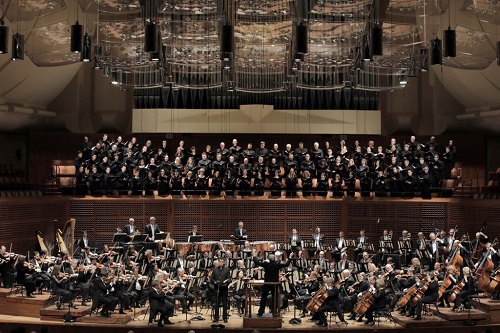 United States Berlioz, Roméo et Juliette: Sasha Cooke (mezzo-soprano), Nicholas Phan (tenor), Luca Pisaroni (bass-baritone), San Francisco Symphony and Chorus / Michael Tilson Thomas (conductor). Davies Symphony Hall, San Francisco. 28.6.2017. (HS)
United States Berlioz, Roméo et Juliette: Sasha Cooke (mezzo-soprano), Nicholas Phan (tenor), Luca Pisaroni (bass-baritone), San Francisco Symphony and Chorus / Michael Tilson Thomas (conductor). Davies Symphony Hall, San Francisco. 28.6.2017. (HS)

Roméo et Juliette, Berlioz’s “dramatic symphony,” got a technically impressive, carefully etched, but ultimately dry-eyed reading from the San Francisco Symphony, conductor Michael Tilson Thomas, and three velvet-voiced singers, in the first of four performances that conclude the 2016-2017 regular season.
The quiet scene-setting moments painted moody, gauzy pictures. The bustling bursts of complex music that tie them together emerged with startling clarity. But both the soloists and the conductor seemed to aim for tonal allure as they tamed the romantic ardor, holding back on passion.
If the majestic moments did not quite burst forth as the composer might have intended, there was much pleasure to be had in absorbing the richly textured, unaffected singing. Ragnar Bohlin’s symphony chorus contributed typically precise and responsive work. As for the soloists, heard only at the beginning and end, mezzo-soprano Sasha Cooke set the scene with plangent singing, her accuracy and flow functioning musically like an instrumental soloist. Tenor Nicholas Phan executed his abbreviated role with clarity and panache, especially in the sprightly, witty Queen Mab section of the Prologue.
As Friar Laurence in the finale, bass-baritone Luca Pisaroni combined velvety tone with emphatic declamation, cutting through the orchestral fabric easily. But with score in hand, his part came off as descriptive, rather than persuasive.
That’s one of the confounding things about Berlioz’s version of this Shakespeare tale. It’s neither an opera nor a cantata, although it has elements of both. Vocal sections, despite their allure, function as both story-telling narration and even sometimes a meta-commentary on the Shakespeare play. Friar Laurence is the only actual character, revealing the “mystery” of the title characters’ deaths in the final scene to the assembled Capulets and Montagues. His role is to persuade them to give up their feud, but standing there reading the score didn’t allow him to act as much as the scene wanted.
The music’s hour-and-a-half journey makes the orchestra do most of the heavy lifting. The busy counterpoint in the Introduction came off splendidly, but the long narration set-up of the Prologue grew more deliberate when it could have danced. Section 2 (“Roméo’s sadness”) and Section 3, which includes the (instrumental only) love scene, couldn’t have been more delicately colored. The chorus hit the right sorrowful notes for Julet’s funeral cortège, but the orchestral rendering of the two lovers’ deaths felt surprisingly inert.
Berlioz sets Friar Laurence’s oration and the families’ long rapprochement with brilliant music that can soar magnificently, but this go-round didn’t breathe. It seemed too measured, so the emotional intensity swelled nicely but scaled lower heights than it might have done.
As impressive as the technical elements were, and as fine as the singing was across the board, later performances have a chance to heat up the blood more.
Harvey Steiman